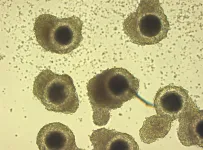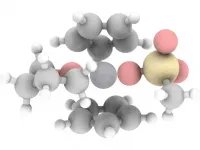This could help pave the way for the emergence of new fungal materials with a host of interesting traits, including sustainability, durability, repairability and adaptability. Through exploring the potential of fungi as components in wearable devices, the study has verified the possibility of using these biomaterials as efficient sensors with endless possible applications.
Fungi to make smart wearables even smarter
People are unlikely to think of fungi as a suitable material for producing gadgets, especially smart devices such as pedometers or mobile phones. Wearable devices require sophisticated circuits that connect to sensors and have at least some computing power, which is accomplished through complex procedures and special materials. This, roughly speaking, is what makes them "smart". The collaboration of Prof. Andrew Adamatzky and Dr. Anna Nikolaidou from UWE Bristol's Unconventional Computing Laboratory, Antoni Gandia, Chief Technology Officer at Mogu S.r.l., Prof. Alessandro Chiolerio from Istituto Italiano di Tecnologia, Torino, Italy and Dr. Mohammad Mahdi Dehshibi, researcher with the UOC's Scene Understanding and Artificial Intelligence Lab (SUNAI) have demonstrated that fungi can be added to the list of these materials.
Indeed, the recent study, entitled "Reactive fungal wearable" and featured in Biosystems, analyses the ability of oyster fungus Pleurotus ostreatus to sense environmental stimuli that could come, for example, from the human body. In order to test the fungus's response capabilities as a biomaterial, the study analyses and describes its role as a biosensor with the ability to discern between chemical, mechanical and electrical stimuli.
"Fungi make up the largest, most widely distributed and oldest group of living organisms on the planet," said Dehshibi, who added, "They grow extremely fast and bind to the substrate you combine them with". According to the UOC researcher, fungi are even able to process information in a way that resembles computers.
"We can reprogramme a geometry and graph-theoretical structure of the mycelium networks and then use the fungi's electrical activity to realize computing circuits," said Dehshibi, adding that, "Fungi do not only respond to stimuli and trigger signals accordingly, but also allow us to manipulate them to carry out computational tasks, in other words, to process information". As a result, the possibility of creating real computer components with fungal material is no longer pure science fiction. In fact, these components would be capable of capturing and reacting to external signals in a way that has never been seen before.
Why use fungi?
On the surface, fungi may seem to pose more than a few major issues. They must be looked after, they decompose, they are only slightly resistant, they may produce odours, and so on. However, most of these issues have already been overcome... and with flying colours. The researcher said: "Generally speaking, working with living organisms entails certain difficulties." With that in mind, and after analysing all their options, the team ultimately chose Basidiomycetes, a division of the fungi kingdom, for their study.
These fungi have less to do with diseases and other issues caused by their kin when grown indoors. What's more, according to Dehshibi, mycelium-based products are already used commercially in construction. He said: "You can mould them into different shapes like you would with cement, but to develop a geometric space you only need between five days and two weeks. They also have a small ecological footprint. In fact, given that they feed on waste to grow, they can be considered environmentally friendly".
The world is no stranger to so-called "fungal architectures", built using biomaterials made from fungi. Existing strategies in this field involve growing the organism into the desired shape using small modules such as bricks, blocks or sheets. These are then dried to kill off the organism, leaving behind a sustainable and odourless compound.
But this can be taken one step further, said the expert, if the mycelia are kept alive and integrated into nanoparticles and polymers to develop electronic components. He said: "This computer substrate is grown in a textile mould to give it shape and provide additional structure. Over the last decade, Professor Adamatzky has produced several prototypes of sensing and computing devices using the slime mould Physarum polycephalum, including various computational geometry processors and hybrid electronic devices."
The upcoming stretch
Although Professor Adamatzky found that this slime mould is a convenient substrate for unconventional computing, the fact that it is continuously changing prevents the manufacture of long-living devices, and slime mould computing devices are thus confined to experimental laboratory set-ups.
However, according to Dehshibi, thanks to their development and behaviour, basidiomycetes are more readily available, less susceptible to infections, larger in size and more convenient to manipulate than slime mould. In addition, Pleurotus ostreatus, as verified in their most recent paper, can be easily experimented on outdoors, thus opening up the possibility for new applications. This makes fungi an ideal target for the creation of future living computer devices.
The UOC researcher said: "In my opinion, we still have to address two major challenges. The first consists in really implementing [fungal system] computation with a purpose; in other words, computation that makes sense. The second would be to characterize the properties of the fungal substrates via Boolean mapping, in order to uncover the true computing potential of the mycelium networks." To word it another way, although we know that there is potential for this type of application, we still have to figure out how far this potential goes and how we can tap into it for practical purposes.
We may not have to wait too long for the answers, though. The initial prototype developed by the team, which forms part of the study, will streamline the future design and construction of buildings with unique capabilities, thanks to their fungal biomaterials. The researcher said: "This innovative approach promotes the use of a living organism as a building material that is also fashioned to compute." When the project wraps up in December 2022, the FUNGAR project will construct a large-scale fungal building in Denmark and Italy, as well as a smaller version on UWE Bristol's Frenchay Campus.
Dehshibi said: "To date, only small modules such as bricks and sheets have been manufactured. However, NASA is also interested in the idea and is looking for ways to build bases on the Moon and Mars to send inactive spores to other planets." To conclude, he said: "Living inside a fungus may strike you as odd, but why is it so strange to think that we could live inside something living? It would mark a very interesting ecological shift that would allow us to do away with concrete, glass and wood. Just imagine schools, offices and hospitals that continuously grow, regenerate and die; it's the pinnacle of sustainable life."
For the Authors of the paper, the point of fungal computers is not to replace silicon chips. Fungal reactions are too slow for that. Rather, they think humans could use mycelium growing in an ecosystem as a "large-scale environmental sensor." Fungal networks, they reason, are monitoring a large number of data streams as part of their everyday existence. If we could plug into mycelial networks and interpret the signals, they use to process information, we could learn more about what was happening in an ecosystem.
INFORMATION:
This research project is in line with Sustainable Development Goal (SDG) 9, to build resilient infrastructure, promote sustainable industrialization and foster innovation.
UOC R&I
The UOC's research and innovation (R&I) are helping 21st-century global societies to overcome pressing challenges by studying the interactions between ICT and human activity, with a specific focus on e-learning and e-health. Over 400 researchers and 50 research groups work among the University's seven faculties and two research centres: the Internet Interdisciplinary Institute (IN3) and the eHealth Center (eHC).
The United Nations' 2030 Agenda for Sustainable Development and open knowledge serve as strategic pillars for the UOC's teaching, research and innovation. More information:research.uoc.edu. #UOC25years





